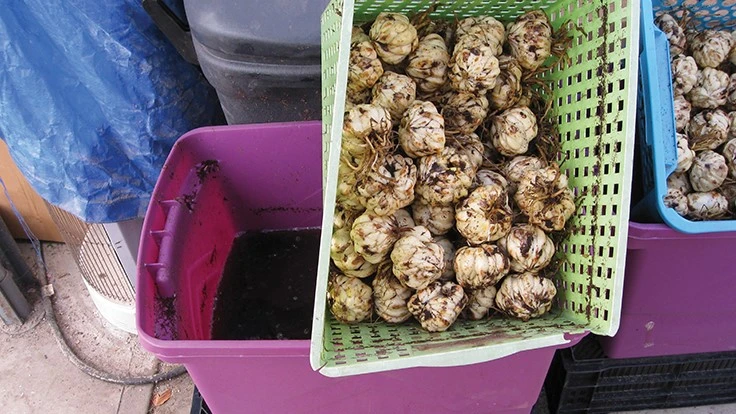

With winter here, so comes the time for forcing bulbs. As with almost every other floriculture crop, plant growth regulators (PGRs) are applied to control growth and improve appearances. Foliar sprays may be used to apply PGRs, but it can be a challenge to get adequate coverage when shoots are emerging and there is limited leaf area to absorb the active ingredients. Substrate drenches are a very effective option for applying PGRs to bulbs, but can be a labor-intensive application method. Bulb dips are an effective and efficient way to treat bulbs with PGRs.
The bulb dipping process is straightforward (Fig. 1). First, bulbs are removed from cases and cleaned of excessive amounts of packing material (i.e., peat moss) they were in. Next, the bulbs are submersed inside a solution — consisting of ancymidol, flurprimidol, paclobutrazol or uniconazole — and allowed to absorb the PGR. Then, the bulbs are removed from the solution, excess solution is allowed to drain and the PGR application is complete.
There are several advantages to this application technique. First, it is an effective way to treat a large quantity of plants efficiently. The only limitation is the size of the container you place the bulbs in and your ability to remove them from the solution once the soak is over. Second, the application environment does not matter. It can be warm or cool, sunny or cloudy — it doesn’t make a difference. However, you’ll want to monitor the PGR solution temperature, as discussed later.
Third, the application timing is flexible. For example, bulb dips can be performed from an hour up to a week prior to planting the crop. Finally, it is an efficient use of PGR product, as the solution can be reused to treat numerous batches of bulbs.
That is not to say there are no challenges to bulb dips. Since bulb dips are performed prior to planting the crop, there are some limitations or precautions that should be taken to avoid problems. First, you don’t know what the environment is going to be like when you force your bulbs. Are you going to be faced with weather that is warmer and sunnier than usual, or are you going to have cooler, overcast conditions? This can make it challenging to try and get exactly the growth control you need with a single PGR application. In general, with any pre-plant PGR treatment like bulb dips or liner dips, using a lower concentration of active ingredient can help avoid over-regulation of growth when growing conditions are suboptimal, and follow-up applications can be made on an as-needed basis.
Another challenge can be achieving uniform control. When bulbs are stored in peat moss in their cases for transport, storage and cooling, some bulbs lose water and dehydrate. When placed into PGR solutions, those dehydrated bulbs soak up more solution than intended and will exhibit excessive growth control from the excessive solution. To avoid this, soak all bulbs in clear water prior to placing them into the PGR solution. The hydrated bulbs will take up little, if any, water, whereas the dehydrated bulbs will soak up as much as they can. In the end, both bulbs end up back at a similar degree of hydration and should absorb similar amounts of PGR when dipped.
You also want to watch your PGR solution temperature. If the PGR solution is too cold or hot, it can diminish PGR uptake by the bulbs. One simple solution is to get your water for the solution ready the day before treating and let it come up (or drop down) to ambient temperature in the greenhouse or headhouse. Alternatively, use a tempered water source.
While we call it a bulb dip, it is a suitable application method to apply PGRs to not only bulbs, but corms, tubers and rhizomes. Consider trying this flexible, efficient and effective method of applying PGRs on other species you grow starting from these types of storage organs. As always, conduct on-site trials under your growing environment, cultural practices and specific cultivars to see what works best under your conditions.

Explore the December 2018 Issue
Check out more from this issue and find your next story to read.
Latest from Greenhouse Management
- Anthura acquires Bromelia assets from Corn. Bak in Netherlands
- Top 10 stories for National Poinsettia Day
- Langendoen Mechanical hosts open house to showcase new greenhouse build
- Conor Foy joins EHR's national sales team
- Pantone announces its 2026 Color of the Year
- Syngenta granted federal registration for Trefinti nematicide/fungicide in ornamental market
- A legacy of influence
- HILA 2025 video highlights: John Gaydos of Proven Winners





